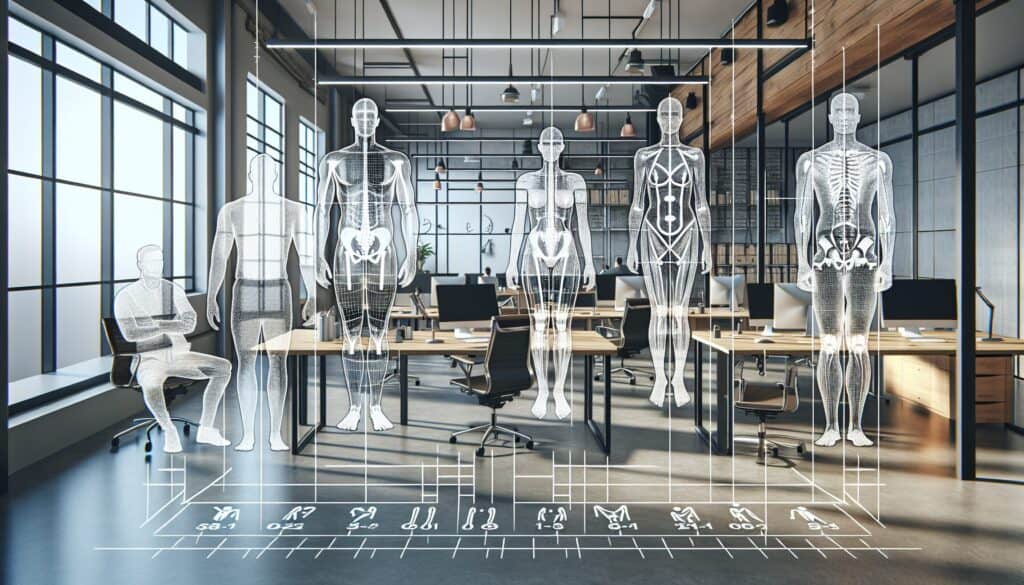The study of human body measurements and proportions to inform the design of workspaces, equipment, and products to fit the user population.
- Méthodologies : Ingénierie, Qualité
Analyse anthropométrique

Analyse anthropométrique
- Conception pour la fabrication additive (DfAM), Conception pour la fabrication (DfM), Optimisation de la conception, Ergonomie, Facteurs humains, Conception centrée sur l'humain, Utilisabilité, Expérience utilisateur (UX), User-Centered Design
Objectif :
Comment il est utilisé :
- Involves using anthropometric data (e.g., height, reach, limb lengths) of the target user population to ensure that designs are dimensionally compatible with their physical characteristics.
Avantages
- Helps design products and environments that are comfortable, safe, and efficient to use for the target population; reduces physical strain and errors; can improve user satisfaction.
Inconvénients
- Anthropometric data varies by population (age, gender, ethnicity) and needs to be current; designing for a wide range of users (e.g., 5th to 95th percentile) can be challenging; static measurements may not fully capture dynamic task requirements.
Catégories :
- Ergonomie, Conception de Produits
Idéal pour :
- Using human body measurements to design workspaces, tools, and products that fit the intended users.
Anthropometric Analysis applies extensively across various industries, including ergonomics, le design industriel, and healthcare, facilitating the creation of tools, equipment, and workspaces that are inherently user-centric. This methodology is often employed during the early stages of product development, typically in user research and concept design phases, where understanding the physical characteristics of the target user population is pivotal. Participants in this process include product designers, engineers, ergonomists, and market researchers, who collaborate to gather and analyze anthropometric data relevant to their specific demographic. Industries such as automotive and aerospace rely heavily on this analysis, ensuring that vehicle interiors and control interfaces accommodate diverse user heights and body shapes, thereby enhancing safety and comfort. Similarly, in healthcare, ergonomic design of medical instruments and patient handling equipment is informed by anthropometric data, directly impacting healthcare outcomes through improved usability. The application extends to consumer products like furniture, where knowledge of human dimensions informs the ergonomic design of chairs and tables, ensuring that they can be used comfortably across a broad range of body sizes. This attention to anthropometric details not only reduces physical strain but also minimizes the risk of injury and errors during use, thereby enhancing operational efficiency and user satisfaction in multiple contexts.
Principales étapes de cette méthodologie
- Identify the target user population and their representative anthropometric data.
- Select relevant dimensions based on specific tasks or interactions required by the design.
- Analyze the distribution of the selected data to determine the design limits (minimum and maximum values).
- Create design envelopes that accommodate the diverse range of body sizes and shapes within the user population.
- Iterate design concepts based on ergonomics principles and user interface interactions.
- Prototype and evaluate designs with a sample of the target population for usability testing.
- Refine designs based on feedback and performance observations to enhance fit and comfort.
Conseils de pro
- Incorporate segmental data to refine ergonomic assessments, focusing on the distribution of body proportions among different demographics.
- Utilize dynamic anthropometry by assessing movement patterns and workspace interactions to create adaptable designs that accommodate varying user scenarios.
- Implement iterative prototyping based on anthropometric data to validate design dimensions through user testing, ensuring comfort and functionality align with real-world applications.
Lire et comparer plusieurs méthodologies, nous recommandons le
> Référentiel méthodologique étendu <
ainsi que plus de 400 autres méthodologies.
Vos commentaires sur cette méthodologie ou des informations supplémentaires sont les bienvenus sur le site web de la Commission européenne. section des commentaires ci-dessous ↓ , ainsi que toute idée ou lien en rapport avec l'ingénierie.
Contexte historique
1986
(si la date est inconnue ou n'est pas pertinente, par exemple "mécanique des fluides", une estimation arrondie de son émergence notable est fournie)

Articles Similaires
Gestion des opérations de fabrication (MOM)
Système d'exécution de la fabrication (MES)
Plan de contrôle de la fabrication
Tests manuels
Tableaux d'évaluation des manutentions manuelles (MAC)
ManTRA (outil d'évaluation des risques liés aux tâches manuelles)